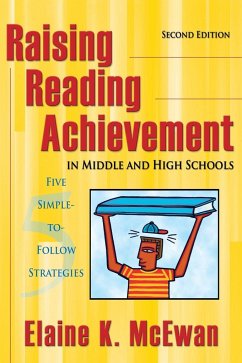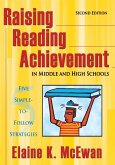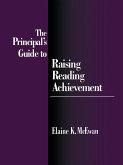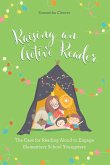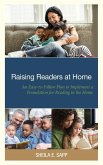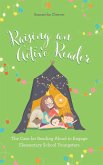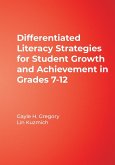Elaine K. McEwan
Raising Reading Achievement in Middle and High Schools
Five Simple-to-Follow Strategies
Elaine K. McEwan
Raising Reading Achievement in Middle and High Schools
Five Simple-to-Follow Strategies
- Gebundenes Buch
- Merkliste
- Auf die Merkliste
- Bewerten Bewerten
- Teilen
- Produkt teilen
- Produkterinnerung
- Produkterinnerung
This second edition enhances the "five big ideas" for raising reading achievement with seven cognitive strategies and more than twenty "teaching for learning" tips for daily instruction.
Andere Kunden interessierten sich auch für
![Raising Reading Achievement in Middle and High Schools Raising Reading Achievement in Middle and High Schools]() Elaine K McEwanRaising Reading Achievement in Middle and High Schools41,99 €
Elaine K McEwanRaising Reading Achievement in Middle and High Schools41,99 €![The Principal's Guide to Raising Reading Achievement The Principal's Guide to Raising Reading Achievement]() Elaine K. McEwanThe Principal's Guide to Raising Reading Achievement32,99 €
Elaine K. McEwanThe Principal's Guide to Raising Reading Achievement32,99 €![Raising an Active Reader Raising an Active Reader]() Samantha CleaverRaising an Active Reader29,99 €
Samantha CleaverRaising an Active Reader29,99 €![Raising Readers at Home Raising Readers at Home]() Sheila E. SappRaising Readers at Home44,99 €
Sheila E. SappRaising Readers at Home44,99 €![Raising Readers at Home Raising Readers at Home]() Sheila E. SappRaising Readers at Home105,99 €
Sheila E. SappRaising Readers at Home105,99 €![Raising an Active Reader Raising an Active Reader]() Samantha CleaverRaising an Active Reader45,99 €
Samantha CleaverRaising an Active Reader45,99 €![Differentiated Literacy Strategies for Student Growth and Achievement in Grades 7-12 Differentiated Literacy Strategies for Student Growth and Achievement in Grades 7-12]() Gayle H. GregoryDifferentiated Literacy Strategies for Student Growth and Achievement in Grades 7-1243,99 €
Gayle H. GregoryDifferentiated Literacy Strategies for Student Growth and Achievement in Grades 7-1243,99 €-
-
-
This second edition enhances the "five big ideas" for raising reading achievement with seven cognitive strategies and more than twenty "teaching for learning" tips for daily instruction.
Hinweis: Dieser Artikel kann nur an eine deutsche Lieferadresse ausgeliefert werden.
Hinweis: Dieser Artikel kann nur an eine deutsche Lieferadresse ausgeliefert werden.
Produktdetails
- Produktdetails
- Verlag: Corwin
- 2. Auflage
- Seitenzahl: 224
- Erscheinungstermin: 5. Oktober 2006
- Englisch
- Abmessung: 260mm x 183mm x 17mm
- Gewicht: 625g
- ISBN-13: 9781412924344
- ISBN-10: 1412924340
- Artikelnr.: 21099106
- Herstellerkennzeichnung
- Libri GmbH
- Europaallee 1
- 36244 Bad Hersfeld
- gpsr@libri.de
- Verlag: Corwin
- 2. Auflage
- Seitenzahl: 224
- Erscheinungstermin: 5. Oktober 2006
- Englisch
- Abmessung: 260mm x 183mm x 17mm
- Gewicht: 625g
- ISBN-13: 9781412924344
- ISBN-10: 1412924340
- Artikelnr.: 21099106
- Herstellerkennzeichnung
- Libri GmbH
- Europaallee 1
- 36244 Bad Hersfeld
- gpsr@libri.de
Elaine K. McEwan is an educational consultant with The McEwan-Adkins Group, offering professional development for educators to assist them in meeting the challenges of literacy learning in Grades Pre K-6. A former teacher, librarian, principal, and assistant superintendent for instruction in several suburban Chicago school districts, Elaine is the award-winning and best-selling author of more than three dozen books for educators. Her Corwin Press titles include Raising Reading Achievement in Middle and High Schools: Five Simple-to-Follow Strategies for Principals, Second Edition (2006), Seven Strategies of Highly Effective Readers: Using Cognitive Research to Boost K-8 Achievement (2004), Ten Traits of Highly Effective Principals: From Good to Great Performance (2003), Making Sense of Research: What's Good, What's Not, and How to Tell the Difference (2003), Seven Steps to Effective Instructional Leadership, Second Edition (2003), Teach Them ALL to Read: Catching the Kids Who Fall through the Cracks (2002), and Ten Traits of Highly Effective Teachers: How to Hire, Mentor, and Coach Successful Teachers (2001). McEwan was honored by the Illinois Principals Association as an outstanding instructional leader, by the Illinois State Board of Education with an Award of Excellence in the Those Who Excel Program, and by the National Association of Elementary School Principals as the National Distinguished Principal from Illinois for 1991. She received her undergraduate degree in education from Wheaton College and advanced degrees in library science (MA) and educational administration (EdD) from Northern Illinois University.
List of Teaching for Learning Tips
Preface
A Change in Focus
The Goals of This Book
Who This Book Is For
What This Book Is Not
Overview of the Contents
A New Feature
The Challenge
Acknowledgments
About the Author
1. Reading Achievement: Where Do We Stand?
Raising Achievement Expectations
The State of Reading Achievement in the Nation
The Response of Educators
The State of Reading Achievement in the States
Roadblocks to Raising Achievement in Middle and High Schools
The Responsibility of School Leaders
Reflection and Discussion Questions
2. Focus on Changing What You Can Change
Change the Educational Paradigm
Change How Goals Are Set
Change How Teachers Teach
Change the Curriculum and How It Is Chosen
Change the Alignment of the Curriculum
Change the Amount of Time Allocated to Reading Instruction
Change Where Strategic Reading Instruction Is Provided
Change How Learning Is Assessed
Change Expectations for Students
Change How Professional Development Is Provided
Reflection and Discussion Questions
3. Teach the Students Who Can't Read How to Read
How Children Learn to Read: A Short Lesson
Failing to Learn
Programs to Remediate Struggling Secondary Students
Find the Students in Special Education Who Can't Read and Teach Them to
Read
Reflection and Discussion Questions
4. Teach Every Student How to Read to Learn
Reading to Learn and Cognitive Strategies
The Strategic Teacher
How to Teach Cognitive Strategies
Reading to Learn and Vocabulary Development
Reading to Learn and Knowledge Acquisition
How We Can Engage More Students in Reading to Learn
Cognitive Strategy Instruction at Alief Hastings High School
Reflection and Discussion Questions
5. Motivate Every Student to Read in the Zone
The Value of Reading a Lot
Reading in the Zone
The Importance of Reading Challenging Fiction and Nonfiction
The Importance of Accountability
Motivating Students to Read a Lot
Engaging Students in Reading
Skills to Read With Confidence and Success
Reflection and Discussion Questions
6. Create a Reading Culture in Your School
Pay Attention to the Basic Beliefs and Core Values of Stakeholders
Determine What Needs to Be Changed
Identify the Roadblocks to Change
Hire a Strong (Assertive) Instructional Leader
Hold Everyone Accountable
Make a Plan
Don't Forget the Parents and Kids
Assess for Learning
Press Academically and Be Instructionally Tenacious
Getting the Job Done at Griffin Middle School
Reflection and Discussion Questions
Resource A. Assessment Tools
Resource A.1: Prereading Assessment Form
Resource A.2: Prereading Assessment Key
Resource A.3: Postreading Assessment Form
Resource A.4: Postreading Assessment Key
Resource B. Programs for Learning to Read in Secondary School
Benchmark Program
Corrective Reading
Higher-Order Thinking Skills (HOTS)
Language!®
Lindamood-Bell Learning Processes
Reading Is FAME
Reasoning and Writing
REWARDS (Reading Excellence: Word Attack and Rate Development Strategies)
The Spalding Method
Spelling Through Morphographs
Resource C. Creating a Strong Reading Culture: A Process Exercise
Description
Application
Time Required
Materials
Administration Directions
References
Index
Preface
A Change in Focus
The Goals of This Book
Who This Book Is For
What This Book Is Not
Overview of the Contents
A New Feature
The Challenge
Acknowledgments
About the Author
1. Reading Achievement: Where Do We Stand?
Raising Achievement Expectations
The State of Reading Achievement in the Nation
The Response of Educators
The State of Reading Achievement in the States
Roadblocks to Raising Achievement in Middle and High Schools
The Responsibility of School Leaders
Reflection and Discussion Questions
2. Focus on Changing What You Can Change
Change the Educational Paradigm
Change How Goals Are Set
Change How Teachers Teach
Change the Curriculum and How It Is Chosen
Change the Alignment of the Curriculum
Change the Amount of Time Allocated to Reading Instruction
Change Where Strategic Reading Instruction Is Provided
Change How Learning Is Assessed
Change Expectations for Students
Change How Professional Development Is Provided
Reflection and Discussion Questions
3. Teach the Students Who Can't Read How to Read
How Children Learn to Read: A Short Lesson
Failing to Learn
Programs to Remediate Struggling Secondary Students
Find the Students in Special Education Who Can't Read and Teach Them to
Read
Reflection and Discussion Questions
4. Teach Every Student How to Read to Learn
Reading to Learn and Cognitive Strategies
The Strategic Teacher
How to Teach Cognitive Strategies
Reading to Learn and Vocabulary Development
Reading to Learn and Knowledge Acquisition
How We Can Engage More Students in Reading to Learn
Cognitive Strategy Instruction at Alief Hastings High School
Reflection and Discussion Questions
5. Motivate Every Student to Read in the Zone
The Value of Reading a Lot
Reading in the Zone
The Importance of Reading Challenging Fiction and Nonfiction
The Importance of Accountability
Motivating Students to Read a Lot
Engaging Students in Reading
Skills to Read With Confidence and Success
Reflection and Discussion Questions
6. Create a Reading Culture in Your School
Pay Attention to the Basic Beliefs and Core Values of Stakeholders
Determine What Needs to Be Changed
Identify the Roadblocks to Change
Hire a Strong (Assertive) Instructional Leader
Hold Everyone Accountable
Make a Plan
Don't Forget the Parents and Kids
Assess for Learning
Press Academically and Be Instructionally Tenacious
Getting the Job Done at Griffin Middle School
Reflection and Discussion Questions
Resource A. Assessment Tools
Resource A.1: Prereading Assessment Form
Resource A.2: Prereading Assessment Key
Resource A.3: Postreading Assessment Form
Resource A.4: Postreading Assessment Key
Resource B. Programs for Learning to Read in Secondary School
Benchmark Program
Corrective Reading
Higher-Order Thinking Skills (HOTS)
Language!®
Lindamood-Bell Learning Processes
Reading Is FAME
Reasoning and Writing
REWARDS (Reading Excellence: Word Attack and Rate Development Strategies)
The Spalding Method
Spelling Through Morphographs
Resource C. Creating a Strong Reading Culture: A Process Exercise
Description
Application
Time Required
Materials
Administration Directions
References
Index
List of Teaching for Learning Tips
Preface
A Change in Focus
The Goals of This Book
Who This Book Is For
What This Book Is Not
Overview of the Contents
A New Feature
The Challenge
Acknowledgments
About the Author
1. Reading Achievement: Where Do We Stand?
Raising Achievement Expectations
The State of Reading Achievement in the Nation
The Response of Educators
The State of Reading Achievement in the States
Roadblocks to Raising Achievement in Middle and High Schools
The Responsibility of School Leaders
Reflection and Discussion Questions
2. Focus on Changing What You Can Change
Change the Educational Paradigm
Change How Goals Are Set
Change How Teachers Teach
Change the Curriculum and How It Is Chosen
Change the Alignment of the Curriculum
Change the Amount of Time Allocated to Reading Instruction
Change Where Strategic Reading Instruction Is Provided
Change How Learning Is Assessed
Change Expectations for Students
Change How Professional Development Is Provided
Reflection and Discussion Questions
3. Teach the Students Who Can't Read How to Read
How Children Learn to Read: A Short Lesson
Failing to Learn
Programs to Remediate Struggling Secondary Students
Find the Students in Special Education Who Can't Read and Teach Them to
Read
Reflection and Discussion Questions
4. Teach Every Student How to Read to Learn
Reading to Learn and Cognitive Strategies
The Strategic Teacher
How to Teach Cognitive Strategies
Reading to Learn and Vocabulary Development
Reading to Learn and Knowledge Acquisition
How We Can Engage More Students in Reading to Learn
Cognitive Strategy Instruction at Alief Hastings High School
Reflection and Discussion Questions
5. Motivate Every Student to Read in the Zone
The Value of Reading a Lot
Reading in the Zone
The Importance of Reading Challenging Fiction and Nonfiction
The Importance of Accountability
Motivating Students to Read a Lot
Engaging Students in Reading
Skills to Read With Confidence and Success
Reflection and Discussion Questions
6. Create a Reading Culture in Your School
Pay Attention to the Basic Beliefs and Core Values of Stakeholders
Determine What Needs to Be Changed
Identify the Roadblocks to Change
Hire a Strong (Assertive) Instructional Leader
Hold Everyone Accountable
Make a Plan
Don't Forget the Parents and Kids
Assess for Learning
Press Academically and Be Instructionally Tenacious
Getting the Job Done at Griffin Middle School
Reflection and Discussion Questions
Resource A. Assessment Tools
Resource A.1: Prereading Assessment Form
Resource A.2: Prereading Assessment Key
Resource A.3: Postreading Assessment Form
Resource A.4: Postreading Assessment Key
Resource B. Programs for Learning to Read in Secondary School
Benchmark Program
Corrective Reading
Higher-Order Thinking Skills (HOTS)
Language!®
Lindamood-Bell Learning Processes
Reading Is FAME
Reasoning and Writing
REWARDS (Reading Excellence: Word Attack and Rate Development Strategies)
The Spalding Method
Spelling Through Morphographs
Resource C. Creating a Strong Reading Culture: A Process Exercise
Description
Application
Time Required
Materials
Administration Directions
References
Index
Preface
A Change in Focus
The Goals of This Book
Who This Book Is For
What This Book Is Not
Overview of the Contents
A New Feature
The Challenge
Acknowledgments
About the Author
1. Reading Achievement: Where Do We Stand?
Raising Achievement Expectations
The State of Reading Achievement in the Nation
The Response of Educators
The State of Reading Achievement in the States
Roadblocks to Raising Achievement in Middle and High Schools
The Responsibility of School Leaders
Reflection and Discussion Questions
2. Focus on Changing What You Can Change
Change the Educational Paradigm
Change How Goals Are Set
Change How Teachers Teach
Change the Curriculum and How It Is Chosen
Change the Alignment of the Curriculum
Change the Amount of Time Allocated to Reading Instruction
Change Where Strategic Reading Instruction Is Provided
Change How Learning Is Assessed
Change Expectations for Students
Change How Professional Development Is Provided
Reflection and Discussion Questions
3. Teach the Students Who Can't Read How to Read
How Children Learn to Read: A Short Lesson
Failing to Learn
Programs to Remediate Struggling Secondary Students
Find the Students in Special Education Who Can't Read and Teach Them to
Read
Reflection and Discussion Questions
4. Teach Every Student How to Read to Learn
Reading to Learn and Cognitive Strategies
The Strategic Teacher
How to Teach Cognitive Strategies
Reading to Learn and Vocabulary Development
Reading to Learn and Knowledge Acquisition
How We Can Engage More Students in Reading to Learn
Cognitive Strategy Instruction at Alief Hastings High School
Reflection and Discussion Questions
5. Motivate Every Student to Read in the Zone
The Value of Reading a Lot
Reading in the Zone
The Importance of Reading Challenging Fiction and Nonfiction
The Importance of Accountability
Motivating Students to Read a Lot
Engaging Students in Reading
Skills to Read With Confidence and Success
Reflection and Discussion Questions
6. Create a Reading Culture in Your School
Pay Attention to the Basic Beliefs and Core Values of Stakeholders
Determine What Needs to Be Changed
Identify the Roadblocks to Change
Hire a Strong (Assertive) Instructional Leader
Hold Everyone Accountable
Make a Plan
Don't Forget the Parents and Kids
Assess for Learning
Press Academically and Be Instructionally Tenacious
Getting the Job Done at Griffin Middle School
Reflection and Discussion Questions
Resource A. Assessment Tools
Resource A.1: Prereading Assessment Form
Resource A.2: Prereading Assessment Key
Resource A.3: Postreading Assessment Form
Resource A.4: Postreading Assessment Key
Resource B. Programs for Learning to Read in Secondary School
Benchmark Program
Corrective Reading
Higher-Order Thinking Skills (HOTS)
Language!®
Lindamood-Bell Learning Processes
Reading Is FAME
Reasoning and Writing
REWARDS (Reading Excellence: Word Attack and Rate Development Strategies)
The Spalding Method
Spelling Through Morphographs
Resource C. Creating a Strong Reading Culture: A Process Exercise
Description
Application
Time Required
Materials
Administration Directions
References
Index

